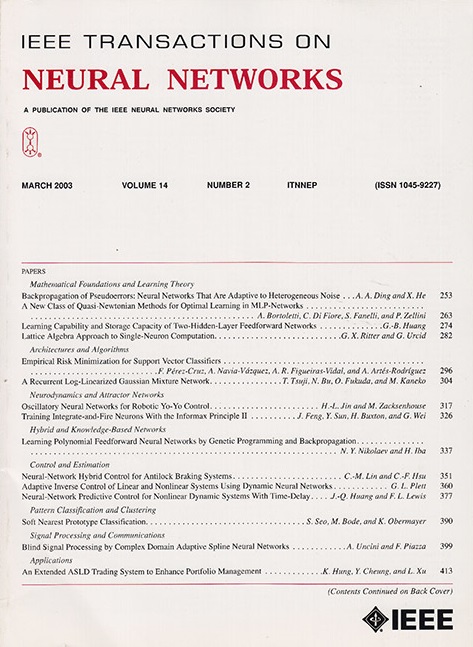通过局部颗粒球密度识别异常值。
IF 8.9
1区 计算机科学
Q1 COMPUTER SCIENCE, ARTIFICIAL INTELLIGENCE
IEEE transactions on neural networks and learning systems
Pub Date : 2025-07-08
DOI:10.1109/tnnls.2025.3578074
引用次数: 0
摘要
现有的基于密度的离群值检测方法在单个样本的单粒度级别处理数据,需要计算所有样本之间的成对距离,并且对噪声具有高灵敏度。基于单粒度的处理范式无法挖掘数据中多个粒度层次的信息,而且这些方法大多忽略了数据中潜在的不确定性信息,如模糊性,导致无法有效地检测数据中潜在的异常值。颗粒球计算(GBC)作为一种新型的颗粒计算方法,具有多粒度和鲁棒性的特点,很好地弥补了上述缺点。在本研究中,我们提出了基于颗粒球密度的局部离群值(GBDO)检测,以提高基于密度的方法的性能。在GBDO中,我们首先通过模糊关系识别每个GB的$k\text{-}$相似性颗粒球(GB)邻域。然后,通过定义的可达性相似度计算GBs的局部可达性相似度密度。最后,根据GB的局部可达性相似密度计算样本的局部GB离群因子。我们采用以gb为基本单位的多粒度处理范式,利用gb的多粒度特性,降低了计算复杂度,提高了对噪声数据的鲁棒性。通过与现有方法的比较,验证了该方法的有效性。源代码和数据集可在https://github.com/Mxeron/GBDO上公开获得。本文章由计算机程序翻译,如有差异,请以英文原文为准。
Identifying Outliers via Local Granular-Ball Density.
Existing density-based outlier detection methods process data at the single-granularity level of individual samples, requiring pairwise distance calculations between all samples and exhibiting high sensitivity to noise. The single-granularity-based processing paradigm fails to mine the information at multiple levels of granularity in data, and most of these methods ignore the potential uncertainty information in data, such as fuzziness, resulting in an inability to effectively detect potential outliers in data. As a novel granular computing method, Granular-Ball Computing (GBC) is characterized by its multi-granularity and robustness, which makes it able to make up for the above drawbacks well. In this study, we propose local Granular-Ball Density-based Outlier (GBDO) detection to improve the performance of the density-based methods. In GBDO, we first identify the $k\text {-}$ similarity Granular-Ball (GB) neighborhoods of each GB via the fuzzy relations among them. Subsequently, the local reachability similarity density of the GBs is calculated through the reachability similarity we defined. Finally, the local GB outlier factors of the samples are calculated based on the local reachability similarity density of the GBs. We adopt a multi-granularity processing paradigm using GBs as the basic units, which reduces computational complexity and improves robustness to noisy data by leveraging the multi-granularity nature of GBs. The experimental results demonstrate the effectiveness of GBDO by comparing it with state-of-the-art methods. The source code and datasets are publicly available at https://github.com/Mxeron/GBDO.
求助全文
通过发布文献求助,成功后即可免费获取论文全文。
去求助
来源期刊

IEEE transactions on neural networks and learning systems
COMPUTER SCIENCE, ARTIFICIAL INTELLIGENCE-COMPUTER SCIENCE, HARDWARE & ARCHITECTURE
CiteScore
23.80
自引率
9.60%
发文量
2102
审稿时长
3-8 weeks
期刊介绍:
The focus of IEEE Transactions on Neural Networks and Learning Systems is to present scholarly articles discussing the theory, design, and applications of neural networks as well as other learning systems. The journal primarily highlights technical and scientific research in this domain.
 求助内容:
求助内容: 应助结果提醒方式:
应助结果提醒方式:


